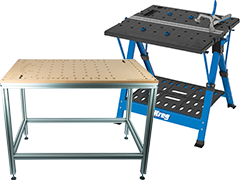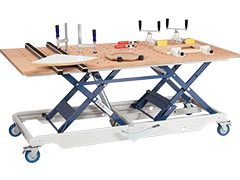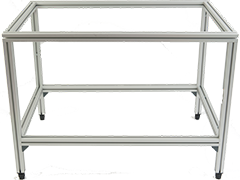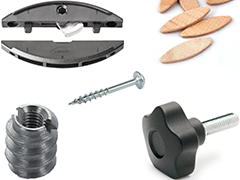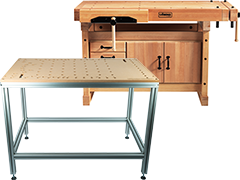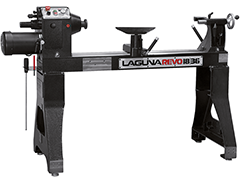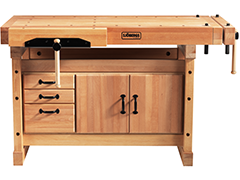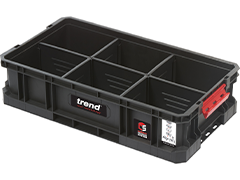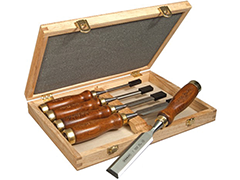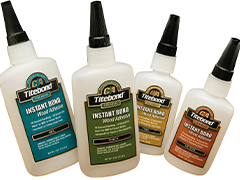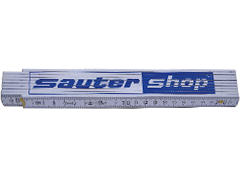- Workshop Equipment
Workshop Equipment
A well-equipped workshop must offer space to work and make it easy to keep things tidy. For this purpose, on the one hand we offer you a variety of workbenches, multifunctional tables, workbenches and work trestles.
On the other hand, we also keep various organisational aids in stock, such as tool cases, Systainers for tool and machine storage, assortment boxes for small parts, fittings and consumables. With Festool pull-outs, you can build a shelving system for Systainers that exactly meets your wishes and needs.
The wood workshop: Workplace, retreat, hobby room
The wood workshop is a place of retreat and a space where you can live out your creativity. It is a production site where you make pieces of furniture in order to live sustainably and conserve resources while also saving money. The following text is a small handout for private individuals who are dealing with woodwork for the first time and who want to set up their first hobby workshop.
First of all, two basic factors need to be clarified:
- The size of the workshop room: There are no limits to the size of the room, neither upwards nor downwards. In most cases, the available space will determine what is possible. Ideally, a beginner will have a room with 12 to 15 square metres at his or her disposal. If there are a few square metres more, so much the better.
- The level of one's woodworking knowledge and skills: These also play a decisive role in setting up the first workshop. Many power tools and stationary machines require experience and know-how to operate them safely. It is often advisable to gain experience with a smaller or simpler version first and only switch to a more expensive version later.
Basic equipment for hand tools
The basic equipment of every woodworking shop includes a workstation and a number of hand tools. Often this is enough to produce the first workpieces. You certainly don't need a large machine park or a lot of power tools. Handicraft teaches the beginner important basic skills in dealing with wood as a material and in working methods, which will later benefit him again and again when using power tools and machines. The purchase of hand tools is therefore a worthwhile investment.
In our programme you will find the hand tools and aids mentioned below. The following list does not claim to be complete. It can and should be modified, shortened or supplemented according to your own interests.
- Measuring and marking tools
- Clamping tools
- Chisel
- Planes
- Saws
- Grinding and sharpening tools
- Wood glues
- Dowels
- Furniture connectors
- Personal safety equipment
- Workshop vacuum cleaner
- Work table/workbench (multifunctional table or workbench)
You should pay special attention to the work table. The workbench or multifunctional table (or both) will play an extremely important role in your work in the workshop later on, when you have gained experience. It is therefore worthwhile to inform yourself as thoroughly and comprehensively as possible before purchasing. You should not compromise on quality for reasons of cost, but rather buy one size smaller.
Important power tools
Among the most important power tools, which are often found in workshops where mainly hand tools are used, are the electric hand drill and the hand circular saw. In most cases, they also form the basis on which a mechanised workshop is built.
- Today, hand drills are usually found as cordless drills and screwdrivers. The generally somewhat lower power than the corded version is more than made up for by mobility and flexibility. If you have to drill a large number of holes or screw in screws, you will quickly appreciate the ease of work provided by the cordless drill. If you don't want to buy a pillar drill later, it is also worth buying a corded drill and a drill stand in addition to the cordless drill, so that you can drill more precisely and with a high degree of repeatability.
- For many woodworkers, the hand-held circular saw is the second power tool to be purchased. Cutting raw wood and wood-based panels is made much easier and faster with the hand-held circular saw. But equally important is the gain in accuracy that the machine itself offers: Cutting angles between 45° and 90° to the workpiece surface can be set on most hand-held circular saws, often the angle range is even greater. If you also use a guide rail, cuts at any angle to the material edge can be made very precisely. Therefore, the purchase of a guide rail is highly recommended, especially as it can also be used with the router. If the guide rail is then used in conjunction with a multifunction table, there is a further gain in precision, ease of work and versatility.
The two power tools that are often purchased at the beginning (or soon after) together with the drill and hand-held circular saw are the router and a grinder.
- The router is a real jack-of-all-trades in the woodworking shop. Even in its simplest configuration (with a rip fence or on the guide rail), it can be used to mill or profile material edges flush, cut rabbets and grooves and make many basic wood joints. If you use the router in a router table, the possibilities are almost limitless.
- Opinions differ on the question of how to achieve the highest surface finish. One faction leaves nothing to be desired over manual processing with a plane and scraper, the other swears by the use of sandpaper in increasingly finer grits. If you prefer working with sandpaper, it is advisable to work with sanding machines: Sanding a larger tabletop through several graduations by hand is anything but a pleasure. A random orbital sander is recommended as the first sanding machine (which can often remain the only one) because of the high surface quality.
On the way to a well-equipped woodworking shop
Once you have the basic equipment of hand tools and the most important power tools, the next stage of expansion is to acquire auxiliary devices, power tools and machines with which the range of work can be considerably expanded.
- First and foremost is the multifunctional table. Its many mounting and attachment options for clamping devices, guides, fixtures, power tools and machines mean that it will soon become a work centre in many workshops, used for almost all projects.
- The same applies to the router table. It is only with it that the full potential of the router can be exploited. Both large and very small workpieces can be processed much more safely and easily on the router table than with the hand-held router. A high-quality and well-equipped router table can almost match a traditional bench router in terms of functionality, but without taking up so much space and putting so much strain on the budget. In addition, the router table places significantly higher demands on expertise in order to be able to work on it safely.
- Another router tool is the router sled which can be used to dress and join workpieces. It is recommended if you also work with raw wood, but want to do without a jointer and thickness planer for reasons of cost or space. With our sauter router sled SlabMatrix , you can also mill workpieces to finished size, which is not possible with planers or the router sleds of other manufacturers.
- At this point at the latest, many woodworkers will think about purchasing a jigsaw, as hand saws and table saws are not capable of making tight cuts. When sawing arcs, circles and irregular shapes, the jigsaw feels at home, as it does when sawing in the face of a workpiece. In this last job, it is even superior to the band saw.
- Finally, at this stage of workshop expansion, you can also purchase a table saw - if the available space is sufficient. This criterion is always met by the small and mobile circular table saws in our range, which are also suitable for mobile use.
Conclusion: Small is possible, but the sky's the limit
The workshop of the ambitious woodworker can be very small - a corner of the home is enough for some specialities such as marquetry or carving - but your own woodworking shop can easily compete with the premises of many a professional carpenter or joiner.
One's own preferences in working with wood should always be decisive. They determine whether one will purchase larger woodworking machines (e.g. band saw, jointer and thickness planer, cross-cut and mitre saw or CNC router) in addition to the above-mentioned equipment levels with hand and power tools.
